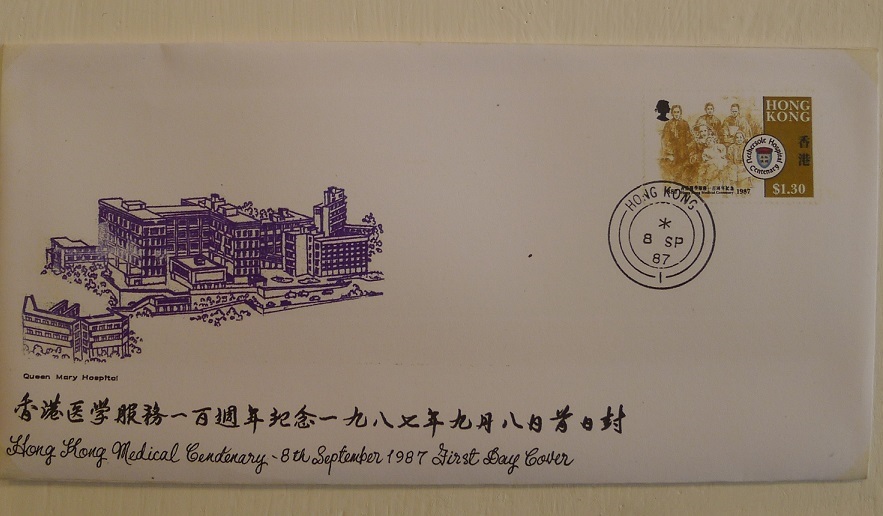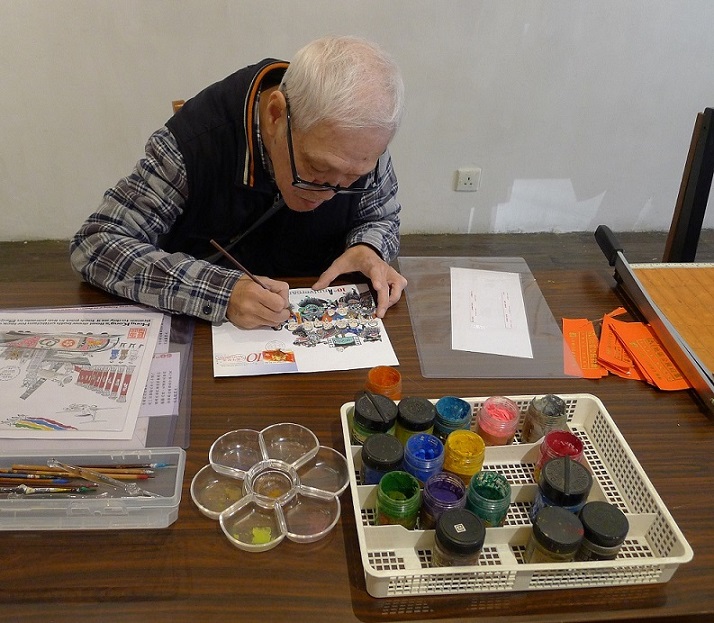Reviews & Articles
駱家驄: 郵謎浪蕩 | Lok Ka-chung: Wandering in the Labyrinth of Stamps
John BATTEN
at 6:04pm on 23rd April 2018




Caption:
1. Lok''s drawing on envelope with stamp. Illustration of Queen Mary Hospital by Lok Ka Chung.Courtesy the artist and John Batten.
2.-3. Lok Ka-chun drawing in Green Wave, February 2018.
4. An installation of envelopes in the shape of China.
(原文以英文發表,評論碧波押之〈郵謎浪蕩 - 駱家驄給香港的一萬張手繪封〉展。Please scroll down for English version.)
傳統上,人們一直在爭論藝術與工藝的優點。一般而言,藝術界已經賦予藝術更高的地位,認為藝術家具有個人創造性的視野,而工匠則遵循他或她的手藝的傳統。然而,為了實現藝術項目,雕塑家依靠匿名鑄造工人的專業技能鑄造青銅雕塑,而無名的主印刷師協助不熟悉印刷技術的藝術家。現在藝術界已經接受了已成名的藝術家構思作品時把製作過程交給其他專業人士和助理的事實。越來越普遍的是藝術家將這些專業人士列為項目的共同合作者。自動化的趨勢也使得工匠的工藝品更為少見。因此,手工製品現在具有很高的威望,不再被視為僅僅是民間手工藝。
大約十年前,我被要求編輯一本關於建築模型製作的書。我拿到了一份作者鍾經洋的手稿,務實的標題寫著「我在香港的32年模型製作的經歷」。雖然文章不浮誇,但是我、鍾經洋和我的出版商花了很多時間調整它,並且把它變成更好的故事。我們用了很久。當這本書在2012年最終出版時,標題已經變成了「我在香港的36年模型製作的經歷」。這本書展示了鍾先生精心製作的住宅、商業和工程建築模型的許多圖像,描繪了香港城市發展歷史的另一面。作為專業建築模型製作人,鍾先生的技術和藝術視野是這本書的基礎,其美麗而巧妙地構建的模型呈現了獨特的藝術形式。他的作品和任何藝術家的三維建築一樣有技巧。香港會議展覽中心的「爆炸視圖」就是一個很好的例子,可以在建築物的主大廳看到。
如果鍾先生用他的建築模型表達了香港建築歷史的一面,那麼駱家聰的郵票收藏和他的插圖描繪了香港和中國大陸的另一種視覺歷史。駱先生的收藏非常龐大,在展覽中他分三個階段展出作品。展覽名稱是「郵謎浪蕩-駱家驄給香港的一萬張手繪封」,而地點是油麻地碧波押 Green Wave Art。當他在香港珠寶行業工作時,駱先生作為插畫師的技能得到了提升。現年70歲的他在過去的40年裡一直在收集郵票,並在他們所附的信封上添加相關插圖。他描繪的內容涵蓋了中國和香港的重大事件、節日和周年紀念,並以政治和社會領袖為特色,特別是推翻清朝後中國的第一任總統孫中山。駱先生在一系列插圖信封上簡潔地表達了孫中山的故事,以及他在亞洲、美國和歐洲為武裝推翻清朝而籌集資金的努力。駱先生通過描繪現代中國及其歷史上的許多動亂,包括最近的雨傘革命等有爭議的事件來擴展這段歷史。
駱先生的藝術源自商業插畫技巧,但他的方法的大膽和他對在香港和中國對生活不拘一格的描繪說明他的收藏不是純粹為了紀錄事實。他富有表現力的風格以及這個為期40年的龐大工程使得駱先生的系列成為香港的一個獨特概要,彷如於18世紀和19世紀的中國貿易油畫一樣。在香港、澳門和廣州畫畫的工匠們都以畫家的身份受到尊重。而駱家聰也會因他對當代生活的另類描繪而得到同樣的尊重也是毋庸置疑的。
Lok Ka-chung: Wandering in the Labyrinth of Stamps
by John Batten
Traditionally, there has been debate between the merits of ‘art’ versus ‘craft’. Generally, the art world itself has given higher status to ‘art’ over ‘craft’, arguing that an artist has an individually creative vision whereas an artisan follows the traditions of his or her craft. However, to achieve an artistic project sculptors would rely on the anonymous expertise of workers in a foundry to cast a bronze sculpture. Or, nameless master printers would assist artists unfamiliar with printing techniques to pull a print and achieve a higher level of technical competence. Nowadays, the art world has accepted that the fabrication of artworks conceived by established artists relies on the expertise of other professionals and assistants in the art-making process. Increasingly, artists will jointly list those professionals as co-collaborators in art projects. Greater automation has also made the work of an artisan rarer. Consequently, ‘handmade’ now has great prestige and is replacing the notion that handmade items are mere folk craftsmanship.
Nearly a decade ago, I was asked to edit a book on architectural model-making. I was handed a manuscript by its author, King Y. Chung, with the pragmatic title, My 32 Years of Model Making in Hong Kong. Although the text was modest, Chung, myself and the publisher spent great time adjusting the text and developing a story. When the book was finally published in 2012, the title had now become My 36 Years of Model Making in Hong Kong! The book showed many images of the architectural models that Chung had carefully made. Seen through these different residential, commercial and engineering models an alternative history of Hong Kong’s urban development was portrayed. Underlying this presentation was Chung’s skill and artistic vision as a professional architectural model-maker, whose beautiful and skillfully constructed models expressed a unique art-form. His work is as skilled as any artist’s own 3-dimensional constructions. An example of his advanced modeling skills is the “exploded view” of the Hong Kong Convention and Exhibition Centre, which can be seen in the main lobby of the building.
If Chung expresses a version of Hong Kong’s built history through his architectural models, then the remarkable stamp-on-envelope collection of Lok Ka-chung with his added illustrations gives an alternative visual history of Hong Kong and the mainland. Lok’s collection is so large that he exhibited his work in three phases at Green Wave Art in Yau Ma Tei. Lok’s skills as an illustrator were honed when he worked in Hong Kong’s jewellery industry. Now aged 70 years, Lok has spent the last forty years collecting stamps and adding related illustrations on the envelopes on which stamps are attached.
His subjects cover China and Hong Kong’s major events, festivals and anniversaries and feature leading political and social figures. Predominant is the depiction of Sun Yat-sen, the first President of modern China after the overthrow of the Qing Dynasty. The story of Sun and his efforts to raise funds in Asia, USA and Europe for the armed overthrow of the Qing Dynasty is succinctly told by Lok in a series of illustrated envelopes. He expands on that past history by depicting modern China and the many upheavals that have governed its history – including such controversial events as the recent Umbrella protests.
Lok’s art derives from commercial illustration techniques, but the boldness of his approach and his eclectic portrayal of life in Hong Kong and China gives his collection more than just archival or documentary interest. His artistic style has great personal expression and the sheer bulk of this forty-year project makes Lok’s collection a unique compendium of Hong Kong. It is akin to the China Trade paintings of the 18th and 19th-century – the artisans who painted life in Hong Kong, Macau and Canton evolved in history to be seen as respected painters. No doubt, Lok Ka-chung will similarly be honoured for his alternative portrayal of our contemporary times.
This review was originally published in Artomity, March 2018
原文刊於Artomity,2018年3月
